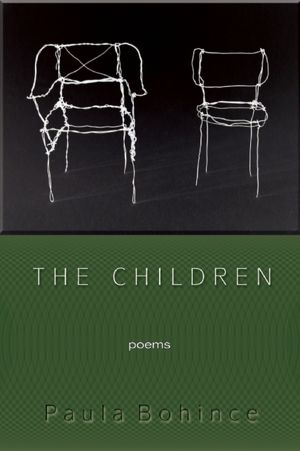Each poem in The Children is alternately spare and dense, delicate and obsessive as filigree or tatted lace. “The heart / breaks its crochet,” she writes in “Snowy River Visions,” alluding to the intricate psychological fabric—handiwork or “white threads / like bandages”—painstakingly made and painfully undone in the course of each poem. — Emily Pulfer-Terino
The Children
by Paula Bohince
Sarabande Books
Paperback. 72 pages. $14.95
In a culture infatuated with irony, Paula Bohince’s poetry distinguishes itself for its subtlety and its acute attention to a world at once beautiful and ravaged. Four years after the release of her stunning debut collection, Incident at the Edge of Bayonette Woods, published by Sarabande Books, The Children, (also by Sarabande), explores nostalgia and the ache of the lucid present in a rural landscape reminiscent of the Pennsylvania countryside where Bohince grew up. Where attention to multiplicity and contradiction could manifest in wry evasion, off-the-cuff colloquialism, and hyper-intellectualism, the imagination in these poems works delicately and relentlessly to make sense of the rift between ideas about the world and the world itself. Bohince tells it slant (to borrow Emily Dickinson’s phrase) only when there is no other way to tell it.
The book is lean and shapely, a collection of forty-two poems divided almost evenly into three sections. Demarcated by Roman numerals, these divisions emphasize thematic links among poems and lend the volume an implied chronology. While these poems are lyrics in free verse, a formal sensibility underlies the collection. For their lapidary precision and for the subjective, accessible “I” delivering each poem, this work feels born of the confessional tradition. Still, poems in The Children are fresh and surprising in their conception, paying homage to Bohince’s predecessors while establishing their own set of rhetorical moves and imaginative leaps. Bohince nods to literary, artistic, and historical figures: Mark Rothko, Virginia Woolf, Amy Clampitt, Herman Melville, Emily Dickinson, and even Christ; invoking a sense of shared personal struggle. The Children articulates myriad forms of witness, addressing themes of childhood, fraught family circumstances, marriage, solitude, and decaying rural communities.
Bohince’s allegiance to beauty functions both as a characteristic and as a subject of the work. Each poem in The Children is alternately spare and dense, delicate and obsessive as filigree or tatted lace. “The heart / breaks its crochet,” she writes in “Snowy River Visions,” alluding to the intricate psychological fabric—handiwork or “white threads / like bandages”—painstakingly made and painfully undone in the course of each poem. Later, in “Froth of the Tides and Further Out,” she claims, “beauty rescues,” then wonders “Is that true?” This work asks what the function of the aesthetic can be in a world marked by loss. The first poem in the collection, “Pussy Willow”, begins:
Faint as flame-in-wind,
I was born, cupped inside a fist
and carried everywhere
even to the formidable river
so that I may see the stones
of the riverbed.
Introducing the essential act of attention at the core of this work, it concludes with a meditation, “Virus in my heart. Branches / salted with buds, soft- / eyed on the sill,” invoking, too, the repose and tenderness to follow. Later in the book, in dazzling strokes, bees are discussed in terms of “the shantung / of them: breathless forms / shuttling through sunlight.” A robin’s egg is “bejeweled on all sides / by goldenrod.” Yellow leaves “become portraits/of fecundity: watercolor / of wanton // against discriminate.” Effulgent phrases offer a complex, excruciating beauty, acting as abrasion and salve at once.
In the title poem, rural, post-rave melancholy is elevated to lyric emblem where “ecstasy lowered to ache” hums at the core of each stanza. Pithy, Anglo-Saxon diction drives a series of propositions and ruminations towards a conclusion equally satisfying and irresolute.
If the wind had been less gutsy
in its unbindings, we’d know them better,
the children
or the afterimage of them,
the teenage couple rapt inside the field
after the rave has died
and dispersed into corn, into cars, into
the trashed curfew.
We’d know them, the two who lay here,
ecstasy lowered to ache
and dull grin, glow sticks faded against
colorless weeds.
If the wind had been less federal,
sweeping anew the corn dust, and the clouds
that kept them starry for hours,
now passive against the noon sky:
if only they’d lasted.
If we’d been given more distinct evidence
beyond the condom listing against milk-
weed, the fox prints, the warmth
of glow sticks in our hands—
neutral again, broken of their magic.
Those dirty pacifiers we suck. Their whistles
we put to mouth and sound.
Plain idiom interacts with decisive formal gestures, lending the subject a surprising elegance and a sonorous elegiac quality. Tercets composed almost entirely of enjambed lines contribute a sense of momentum and also of containment, establishing the writer’s concern for the poem as crafted object while mimicking the energy with which the speaker bares witness to the scene. While none of the lines is end-rhymed and the internal rhymes are subtle as those inherent in colloquial speech, the language is rife with assonance and alliteration. Even in the first sentence, “couple,” “rapt,” “corn,” “cars,” “trashed,” and “curfew” establish a sonically arresting pattern of hard consonants and internal slant-rhymes that continues into the next sentence with “ecstasy lowered to ache.” The poem is built essentially of three propositions: “If the wind had been less gutsy”, “If the wind had been less federal”, “If we’d been given more distinct evidence”. Only the first resolves in a complete sentence; the following are fragments, expressive of incompletion and futility. The “we” who would know them better is literally suggestive of the community from which they are alienated. At the same time, the speaker and the reader are the “we” who know the “afterimage” of the children only through a set of lyric gestures. The poem is itself the afterimage, ghostly and particulate. Here distinctions among the man-made and the natural, the young and the dead, the beatific and the pathetic, collapse in quiet spectacle, acutely observed. The teenagers’ final whistling, which reads as half-habit, half-outcry, lends the poem the luster of ars poetica as writer herself scans the ruin, turning it into song. This work is as much about the ordinary world as it is about our efforts to withstand it.
Bohince unabashedly exalts the quotidian, exposing and even, at times, announcing her ambition. In “The Peacock,” for example, “Dreams feather the pillow and make bearable / the day…” in which dailiness—children’s’ aimless play, a working father’s depression—are juxtaposed with the bird’s “gorgeous body.” The poem turns its attention to the peacock until peachicks flock around the bird and, in a bold flourish, Bohince writes:
The day is finding its Breughel moment—
wine and sapphire and verdigris. His black hair
with sunlight on it.
A miracle. Something to recall
as beautiful, in the future. As the sewer was
in summer. Little childhood river.
Through the poem’s shift of attention from the pedestrian to high art to the sewer, dailiness is transformed, (or the poet announces her desire to transform it), wrought and iridescent. The world in this poem is as much imagined as it is observed, affirming one of the book’s central concerns: the relationship between perception and invention. As is the case with Elizabeth Bishop’s sublime, overwhelmingly lyrical passages are expressive of both affliction and delight.
An acute ambivalence characterizes the collection. In several poems, a subject is both itself and another, tilting and transforming. Beavers damming a stream are conflated with the rope-swinging teenaged boys the speaker used to marvel at. A mother’s frenzied consciousness is likened to birds, a “tonic of quail,” the mind “a cloud of quail…huge / as buckshot / when it balloons down, / scribbling earth/with its landings.” A hornet’s hive is a “collapsing universe” in which the speaker recognizes her own loneliness and collapse. An owl is “embodied psychosis,” “homeless, forever.” A rabbit in a winter field is discussed in the same terms as the speaker’s mother is.
A profound poem of leave taking, “Hare In Snow” responds to Mark Rothko’s vibrant, juxtaposing planes of color and his pulsing nuances. Built of two solid strophes whose rhetorical unfolding is almost identical, the poem reads as a kind of diptych imbued with the symmetry of reflection and of palindrome.
She sits in stately dress; she is all White. Slur of landscape.
In the birches’ breach, she waits: recompense for January’s deadly
beauty; rapid heart beating the downy body. Flaw
in the opal of field. Not-yet blood festival. To be as still
is to protest. Don’t go, I think, half-dozing at the window, when
she goes. Her shaming wakefulness. The poise of long feet
come to use. The adults look babyish all their lives.
It’s Nature’s trick, to feign innocence. Any intelligent thing
rejects the unhappy present. The thought of her alone would be
pretty, were she not true. And cruel as the feminine mind. Gone,
the mist she releases I interpret as Mother’s Hairspray.
She wears her fur, my mother. Pink-cheeked, she is
the landscape. Its cold eternal sunrise. Young and handsome
as my birth month. How rapidly we rushed toward each other
then. How we are the flaw in the other. Her blood slows
down. To be as quiet is to protest. Don’t go, I think, waving
goodbye from my car window. I go, and her waving
shames me. Though she bends, in mirror, in her sweeping,
she will always be younger than I am. It’s a mother’s trick,
to be loved as a lifelong daughter. The thought of her alone
will not do. She is pretty, and true. And cruelty flies into wind-
borne snow. Into the mist my mouth drinks now as milk.
Each dense stanza is built of a series of statements, sentences and sentence fragments, which addresses its subject with alternately literal and imaginative attention. The rabbit in the first strophe arrests the speaker where she sits, drowsy by a window, thinking, “don’t go” as the creature disappears into woods. But the speaker considers the animal’s presence before it runs away, making incisive claims about the natural world that read as philosophical and socio-political as well: “The adults look babyish all their lives. / It’s Nature’s trick, to feign / innocence. Any intelligent thing / rejects the unhappy present.” The poem hinges on this inventing mind, on the speaker’s consciousness that analyzes “any intelligent thing” and that “interpret(s)” the mist of snow as her “Mother’s hairspray,” again juxtaposing the natural and the artificial, the current and the recollected.
The introduction of the speaker’s mother at the hare’s escape prompts further consideration of “Nature’s trick.” Now the mother occupies the space, imagined and actual, that the hare had. She “wears her fur.” She is “young and handsome/as my birth month. How rapidly we rushed toward each other / then,” considers the speaker in a tone redolent with loss, “how we are the flaw in the other.” Again she thinks, “don’t go”, this time as she herself drives away, shamed by the image of her mother waving in the rearview mirror. “It’s the mother’s trick, / to be loved as the lifelong daughter,” she asserts, yoking safety and shame, love and anger, nurturance and dependence, in a set of relationships that throb like Rothko’s planes of color. Mother and daughter are both indistinguishable and achingly separate. The “cruelty” that “flies into wind- / borne snow,” then, is both the speaker’s and the mother’s; it is the pain inherent in parting and reunion. The form—two stanzas rhetorically similar but imaginatively divergent—amplifies the marked and expressive ambivalence informing the poem and so much of this book.
Paula Bohince’s poems delight and hurt. In spite of, or perhaps because of, the complex and palpable struggle informing this collection, The Children is an intricate and distinct pleasure. Shapely and plainspoken, austere and effulgent, this work rewards repeated reading with subtly inventive language and an earnestness that feels unaccustomed and even bold in contemporary poetry. The intellect and the heart are inextricable in this writing that promises to be enduring and influential.
—Emily Pulfer-Terino
————————————————
 Emily Pulfer-Terino grew up in Western Massachusetts, where she lives and teaches English at Miss Hall’s School, a boarding school for girls. She holds a BA from Sarah Lawrence College and an MFA in Creative Writing from Syracuse University. More of her work is published or forthcoming in Hunger Mountain, Numéro Cinq, The Southeast Review, Poetry Northwest, Stone Canoe, The Louisville Review, The Alembic, Oberon, and other journals and anthologies.
Emily Pulfer-Terino grew up in Western Massachusetts, where she lives and teaches English at Miss Hall’s School, a boarding school for girls. She holds a BA from Sarah Lawrence College and an MFA in Creative Writing from Syracuse University. More of her work is published or forthcoming in Hunger Mountain, Numéro Cinq, The Southeast Review, Poetry Northwest, Stone Canoe, The Louisville Review, The Alembic, Oberon, and other journals and anthologies.

